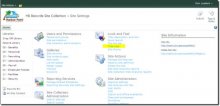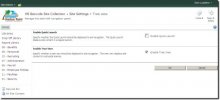Information Lifecycle Management MOSS
 My experience with other Records Managers tells me they expect to navigate their electronic records file plans using a hierarchical tree structure similar to file plan designs of traditional non-electronic records management practices. And while SharePoint 2010 doesn’t technically manage the libraries and folders in this manner, a Records Center site can be easily configured to represent a file plan in a tree view. Here’s how it’s done.
My experience with other Records Managers tells me they expect to navigate their electronic records file plans using a hierarchical tree structure similar to file plan designs of traditional non-electronic records management practices. And while SharePoint 2010 doesn’t technically manage the libraries and folders in this manner, a Records Center site can be easily configured to represent a file plan in a tree view. Here’s how it’s done.
 From the Records Center site, logged in as a user with the proper permissions, click on ‘Site Actions’ and select ‘Site Settings’. Under ‘Look and Feel’, click on ‘Tree View':
From the Records Center site, logged in as a user with the proper permissions, click on ‘Site Actions’ and select ‘Site Settings’. Under ‘Look and Feel’, click on ‘Tree View':
Select ‘Enable Tree View’. (I also recommend deselecting ‘Enable Quick Launch’. This will limit the left-hand pane to one method of navigation and possibly avoid confusing some of you end users.):

Click ‘OK’ and return to your Records Center. Now you should notice that your file plan is presented in the left-hand window pane as a more traditional hierarchical structure:
One note: The tree view option is available on any SharePoint 2010 site and can certainly be used outside of the Records Center if you think it makes sense. I like to limit its use to the Records Center site because it can help the end user better distinguish your organization’s file plan from other libraries and folders in your collaborative spaces.
You might also like


三维设计拐点来临-记2014Bentley电力行业研 — 赛迪网
Bentley 应势推出了自己的资产信息全生命周期管理(Asset Lifecycle Information Management,ALIM)解决方案。不但如此,Bentley 还在近年推出了“中国唯一”和“中国优先”策略,专门成立了一个多达30人的团队,专门针对 ..




